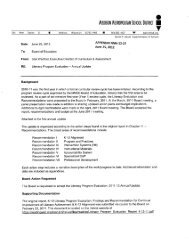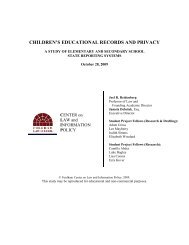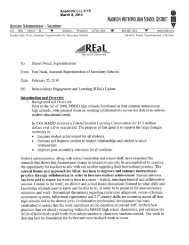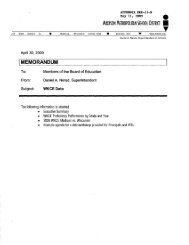interpretations of standards-based grading and reporting - School ...
interpretations of standards-based grading and reporting - School ...
interpretations of standards-based grading and reporting - School ...
You also want an ePaper? Increase the reach of your titles
YUMPU automatically turns print PDFs into web optimized ePapers that Google loves.
Sara Hagen<br />
Chapter 3: L 1 Interference <strong>and</strong> Interlanguage<br />
While learning the language <strong>of</strong> <strong>st<strong>and</strong>ards</strong>-<strong>based</strong> <strong>grading</strong>, teachers are combining<br />
first language (traditional <strong>grading</strong> practices) with new language to create an<br />
interlanguage. This "interlanguage" is a logical transitional step. The two main<br />
interfering practices from traditional <strong>grading</strong> are use <strong>of</strong> percentages <strong>and</strong> use <strong>of</strong> letter<br />
grades. In trying to create a "direct translation" or one-to-one correspondence between<br />
percentages, letter grades, <strong>and</strong> <strong>st<strong>and</strong>ards</strong>-<strong>based</strong> grades, teachers face added frustration.<br />
Awareness <strong>of</strong> <strong>grading</strong> practices that are still influenced by traditional <strong>grading</strong> is the first<br />
step in addressing them, so teachers can move toward a more complete adoption <strong>of</strong><br />
<strong>st<strong>and</strong>ards</strong>-<strong>based</strong> <strong>grading</strong>.<br />
Percentages [page 77]<br />
Teachers are accustomed to assigning grades as percentages. Many teachers have<br />
created systems to convert these percentages to a 1,2,3, or 4. The range <strong>of</strong> 100 possible<br />
scores <strong>of</strong>fers more flexibility to teachers than the four <strong>st<strong>and</strong>ards</strong>-<strong>based</strong> scores or the<br />
traditional five letter grades. Because teachers' <strong>interpretations</strong> <strong>of</strong> the 1, 2, 3, <strong>and</strong> 4 vary,<br />
their systems for converting from percentages also vary. I include four sample <strong>grading</strong><br />
scales [page 79]. A score <strong>of</strong>2 ranges from 60 to 89 percent, grades which previously<br />
corresponded to aD, C, or B. Scores including half-point intervals [see pages 81 <strong>and</strong> 82<br />
for a sample] could increase the accuracy <strong>of</strong> grades <strong>and</strong> decrease teachers' frustration<br />
with the 4-point system.<br />
Letter grades [page 83]<br />
Currently, teachers assign ai, 2, 3, or 4 for each power st<strong>and</strong>ard. If desired,<br />
teachers also assign weights to each power st<strong>and</strong>ard. The grade book s<strong>of</strong>tware then<br />
calculates a weighted average <strong>of</strong> each student's grades to determine a letter grade for<br />
each subject. Letter grades were retained by the district in order to provide continuity for<br />
parents during the transition. Based on teachers' comments, I recommend phasing out<br />
letter grades for the following reasons;<br />
• The purpose <strong>of</strong> <strong>st<strong>and</strong>ards</strong>-<strong>based</strong> <strong>grading</strong> is to provide clear information about<br />
students' progress on individual <strong>st<strong>and</strong>ards</strong>. Amalgamating this information into a<br />
single score seems to defeat this purpose.<br />
• There is no shared meaning <strong>of</strong> the letter grades.<br />
• Some teachers wonder whether a 3, which represents mastery, should be an A.<br />
Dividing lines will always be arbitrary.<br />
• The grades produced by the new system are sometimes very different from those<br />
produced by the traditional <strong>grading</strong> system, which makes the grades seem<br />
incorrect or confusing to teachers <strong>and</strong> parents <strong>and</strong> makes it more difficult to focus<br />
on measuring student underst<strong>and</strong>ing.<br />
• Learning skills do not affect the letter grade, which suggests that they are less<br />
important or unimportant.<br />
• Teachers sometimes adjust the letter grades or <strong>st<strong>and</strong>ards</strong>-<strong>based</strong> scores, resulting in<br />
inconsistencies.<br />
• Letter grades continue to be associated with a norm-referenced system <strong>of</strong> <strong>grading</strong>,<br />
<strong>and</strong> subtly reinforce teachers' expectation <strong>of</strong> a bell-shaped distribution <strong>of</strong> grades.<br />
Page 9











![by Shaina Wright [PDF] Ralph Waldo Emerson Prize 2006 - School ...](https://img.yumpu.com/26083584/1/174x260/by-shaina-wright-pdf-ralph-waldo-emerson-prize-2006-school-.jpg?quality=85)
